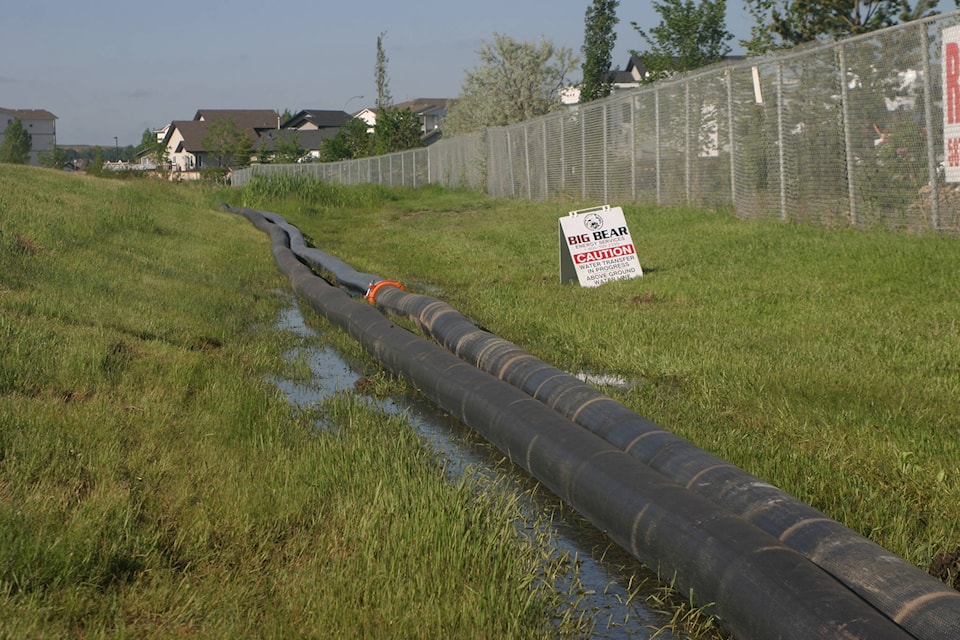Driving around Sylvan Lake, people are likely noticing a number of hoses and pipes running in and out of ditches in town. That equipment is part of a strategy the Town of Sylvan Lake has implemented to dispose of wastewater effluent.
Public Works Manager David Brand stated in a call with the Sylvan Lake News that a temporary system designed to help move treated wastewater effluent into Sylvan Creek and Cygnet Lake. The system, running through the Town’s stormwater drainage system, is utilizing water from Sylvan Lake to help aid the flow of effluent into Sylvan Creek, where it eventually will empty into Cygnet Lake.
“This is to accommodate the situation with the lagoons. Our intent is to help the downstream environment receive effluent from the lagoons,” said Brand. “We’re doing this so [Sylvan Creek and Cygnet Lake] can more easily receive effluent and so we can mitigate any potential environmental impacts.
“People should see little impact in terms of their day-to-day activities. The impact on the lake in terms of the amount diverted is very small, relative to the volume of the lake.”
This measure is being taken to avoid a scenario like the one that took place last year, when wastewater from the lagoons had to be trucked to a treatment plant in Red Deer - a situation that also required the Town to implement water control measures.
In order to aid in the movement of treated effluent, the Town of Sylvan Lake received approval from Alberta Environment and Parks for a temporary diversion license [TDL] to divert water from Sylvan Lake.
According to a media release from the Town, it now has permission to divert up to 1.41 million cubic metres of water over a period of time lasting from June 5 until July 21.
“The license approval is for a maximum of 1.4 million cubic metres, and for 30,000 cubic metres per day,” said Brand. “Last year, we were licensed for 1.8 million cubic metres, and we actually delivered 990,000.”
The release stated the TDL is crucial because it ensures the downstream receiving environment can sustainably receive treated effluent until alternative effluent disposal methods can be implemented. The Town of Sylvan Lake and the ongoing water diversion process are in full compliance with all regulatory controls - including federal and provincial requirements.
“There are certain conditions imposed upon us when we do this work,” said Brand. “One example of a condition in our license is that we have to ensure the withdrawal of the water from [Sylvan Lake] cannot draw down in excess of 3.5 centimetres.”
Brand said if the water withdrawal from the lake exceeds a 3.5 centimetre drop in the water level, the diversion process will be halted. The lake, infrastructure to divert water, and the areas into which the water will be released are all under 24/7 monitoring.
Brand described the measure as a “tide over,” and exclusively to help the downstream receiving environment - it will not increase treatment efficiency of the wastewater lagoons.
“When we discharge that effluent, we want to make sure we mitigate the impact on wildlife and the environment until we can put it in a pipeline, and send the wastewater to Red Deer,” said Brand.
The wastewater diversion taking place in Sylvan Lake comes just after Alberta Transportation’s announcement to fund 90 per cent of the costs associated with a wastewater line from Sylvan Lake to the regional wastewater treatment plant in Red Deer - a long-term solution to the pressures the Town faces with its wastewater infrastructure.
The release also disclosed that the Sylvan Lake Regional Wastewater Commission is working with design consultants, and anticipates construction of the regional wastewater infrastructure to begin as soon as 2018, with its eventual operation to begin no later than 2019.
samuel.macdonald@sylvanlakenews.com
